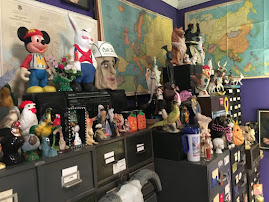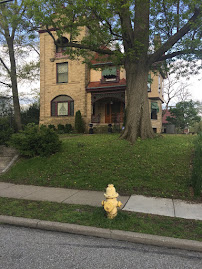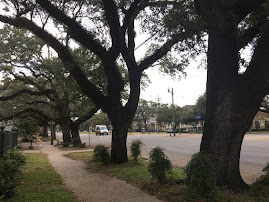St. Louis
Cathedral and Jackson Square
Dear George
We first became admirers of
New Orleans when my parents took us on a vacation there in 1969. Our son J was just three months old at
the time. Then when J and K moved
there in the 1990’s we became enthusiastic annual visitors. Now, with V and L there, our
four-year-old grandchildren, we regard the city as roughly equivalent to
paradise. I went down for a
six-day grandfatherly visit about two weeks ago. Here are some of the highlights.
K, L, and V at
a bridge in City Park
J, K, and the kids live
within walking distance of City Park in Mid-City. With its lush avenues of live oaks, walking trails, picnic
areas, and scenic ponds, it’s like a gigantic playground for the children. We did a couple of park expeditions
during my stay. Here are V and L
building a birds’ nest on one of the bridges.
At the
Sculpture Garden
City Park is also home to the
New Orleans Museum of Art and its adjacent Besthoff Sculpture Garden (Rodin,
Moore, Segal, etc.). The Art
Museum was featuring “Mother of Invention,” a collection of absolutely exquisite,
cutting edge craft and design items (glass, china, jewelry, furniture –
Tiffany, Lalique, etc.) from Worlds’ Fairs as far back as the 1830’s. I also enjoyed the House of Blues folk
art exhibition at the Ogden Museum of Southern Art and numerous art and photo
galleries in the Warehouse District and the French Quarter.
On the train at Global Wildlife
One day we drove across Lake
Pontchartrain on the world’s longest bridge and visited Global Wildlife, a
“safari” like outdoor adventure place where hundreds of African and Indian
animals wandered free in a 900-acre reservation and visitors could feed them
from a train. New herds of animals
rushed up wherever we went, and some gobbled up food right out of the
children’s hands. Here’s L getting
ready to feed the deer.
The catch of
the day
After Global Wildlife, we
went to J and K’s country place on the lake’s North Shore. J went fishing with the kids at the
pond behind the house and caught a two-incher. I proposed it would be fun to put the fish back in the
water, but V was determined to cook and eat it. J cooked; V ate.
At Morris Jeff
The children will soon be
finishing their preschool year at the Morris Jeff charter school, and they’ll enter kindergarten at a Spanish
immersion public school in the fall.
They enjoy school a lot and are doing very well. Both got “purples” (just about the
highest accolade possible) on the day that I visited.
At the Zoo
On Sunday we went to the Zoo
in Audubon Park. With all the
southern flora, it’s beautiful. I
particularly like the Louisiana swamp exhibit with its albino alligators. L not only petted the boa constrictor,
but fed the turtles and touched the elephant’s thick hairy hide.
V and L meet a
goat at the Bayou Bougaloo Festival
The children get exposed to
tons of music in New Orleans. We
made two visits to the Mid-City Bayou Bougaloo Festival which offered three
music stages, numerous art vendors, and other festivities. J took V on a kayak ride in the
canal. Then she wandered off
in the crowd for a while, prompting J to write his cell phone number on her arm
with a magic marker.
My best NOLA
bargain
On days that J and K were
working I took the trolley down Canal St. to the French Quarter, sometimes
transferring to the St. Charles trolley to the Garden District. If you reach a certain esteemed age in
New Orleans, the trolley only costs forty cents. On one trip I only had two quarters available, and the
conductor gave me a paper ticket worth a dime which I could redeem later. It’s exciting to ride the trolley.
The National
World War II Museum
I go to the World War II
museum just about every time I visit.
It’s is such an incredibly powerful place, and, with my dad, uncles, and
family friends having been WW II veterans, it always brings tears to my
eyes. I visited the current
exhibition on POW camps in Germany, the Pacific Theater wing, and the new
Boeing Center featuring a collection of military planes. It was a good precursor for Memorial
Day.
Little Red
Riding Hood and the Wolf
J and K staged performances
of Little Red Riding Hood and the Three Little Pigs for our amusement at City
Park. In this scene Red Riding
Hood is confronted by the Wolf.
Dragon Master
Showcase
The French Quarter was filled
with street musicians and other performers. Dragon Master Showcase were sidewalk gymnasts who carried on
an amusing patter with passers-by as they did their high quality routine at
Jackson Square. One guy skidded 20
feet on the top of his head, no handsies, and another guy did a running
somersault in the air over seven kneeling adult volunteers.
On the backyard
swing
Not to be outdone, V and L
did their own acrobat routines in the back yard at home. J had hooked up a swing from a tall
tree, and the children did daredevil swinging, high in the air, spinning in
circles. I could barely watch.
Iko
I missed our sheepdogs a lot
for the first couple of days, so I took family dog Iko on more walks than he
was accustomed to. He became quite
attached to me as a consequence and decided to sleep in my room at night.
The Spotted Cat
Music Club
I’m not much of a nightlife
person in Cincinnati, but J regularly takes us out to hear local jazz on NOLA
visits, and it’s always thrilling.
This time we went to a couple of clubs in the Marigny neighborhood and
heard some foot-stomping music.
This is Miss Sophie Lee at the Spotted Cat.
The children are four and
two-thirds now. I hadn’t seen them
since Thanksgiving, so the intervening time amounts to about twenty percent of
their lifetimes. As usual, they’ve
grown a lot, particularly by becoming much more verbal. V and I took Iko on several walks in
the neighborhood, and it’s almost like conversing with a young, excitable
adult. L’s a little shyer, but he
has his own sense of humor and gentleness. I’d once again forgotten how demanding a job parenting is,
and two active, high energy children who are much more of a challenge than
one. K and J deserve medals for
their patience, calm, and ever present dedication. The children, of course, provide lots of love and fun. I’m eager to see them again soon.
Love,
Dave
G-mail Comments
-Phyllis S-S
(5-28): Dave, What a great trip -
those statues look wierd though - not Rodin I would assume. The kids are changing so much - and
J*** looks more like you, I think.
Did you do your play/theater with the grandchildren? Canada was terrific. We saw the
best Salome opera I've ever seen, saw Christopher Plummer and his wife (2 rows
in front of us at Measure for Measure) and Brian Dennehey. Phyllis









































































































































































